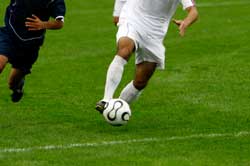Turning & Football
May 13 2008 | Articles

Control
• It is often said that a good first touch is significant in gaining control of the ball.
• If you can accomplish it correctly, the ability to control will greatly improve your performance.
• You can use the feet, thigh, chest or head in controlling the ball. Regardless of which body part you are using, the basics of control remain the same.
• First, immediately position yourself on the ball’s line of flight. Quickly decide on how you want to control the ball.
• In order to have the ability to receive the ball at any height, you must constantly practice your control using your feet, thigh, chest or head.
• When the ball is flying high above your waist area, it will be difficult to use the feet to control it. As such, learning to use the chest will come in handy.
• Approach the ball with the body part you wish to control it with. It can be the thigh or the feet, among other body parts.
• Make sure you get that body part behind the ball. At the same time, make certain that you are covering as much of the ball’s area. If you choose to work with your thigh, make sure the full face of the thigh is in line with the ball. This will help you cushion the force at which the ball will be delivered.
• The ball will then drop to the ground and depending on your position; you can either pass or shoot the ball.
Stop Turns
• For a car to be excellent, it must have a great accelerators as well as effective brakes. Similarly, football players need the ability to increase and decrease their speed at whim.
• Football generally involves running at full speed. While doing this, the player will be able to keep the ball in play. Right before the ball reaches the touchline, the player may perform that magical turn.
• To do this turn, you must immediately halt the ball by placing your foot on top of it. However, the key to this stop and turn is the ability to stop your run in an instant. After you stopped running, turn your body immediately. Do this by pivoting on your planted foot. Then, use your other foot to drive the ball forwards. After this, move away quickly.
• If the turn is successful, you will confuse your opponent and he will end up running in the opposite direction.
• However, if the opponent is too near, you may end up losing the ball. So, make sure that you execute this turn quickly and with adequate space.
Cryuff Turn
• Named after the brilliant Dutchman Johan Cryuff, the Cryuff turn is a skill that, when mastered, can make you the envy of all your team mates.
• This trick is especially helpful when you want to lose your opponent.
• You must position your body like you are going to make a pass. However, instead of kicking, use the inside of the foot to bring the ball behind your standing leg.
• Get yourself in line with the ball by twisting or turning your shoulders and hips. After which, you must instantly start running.
• Your fast manoeuvre will cause the opponent to lose track of your movements.
Dragg Back
• In football, you will often find yourself on the pitch, with all the players crowding near you. The space will then be too tight for you to move well.
• The dragg back turn is deal for manoeuvring in tight spaces. Although the skill may be easy to learn, its success will greatly depend of the speed of the feet.
• The turn begins with your foot placed on top of the ball and this foot must remain in the same position for the rest of the turn. Next, use that foot to roll the ball backwards as you attempt to go to a different area.
• In order to perfect the execution, you will need to practice this skill constantly.
Outside Hook
• Although relatively easy to master, perfect execution of this skill looks incredible on the field.
• This skill is especially helpful in keeping your body between the ball and the opponent.
• In order to do this effectively, you must maintain focus on both the ball and on the opponent who is marking you.
• As you approach the ball, increase the movement in your feet. Then, use the outside of the foot to hook the ball and turn it into your desired direction.
• If you have mastered the skill, you can hook the ball but instead of moving it, step on it. Then, carry on with your original direction.
• Doing this is a double bluff on your opponent.
Inside Hook
• As with any turn, you must position your body in between the ball and the opponent.
• The use of the inside hook turn will be effective in rendering your marker useless.
• Similar to other turns, this technique requires speed and agility in the feet’s movement.
• To do this turn, use your foot to reach the outside of the ball. Making this contact will enable you to alter the direction of the ball.
• You should also bend your knees so you can easily shift your weight. Then, turn your hips to change the direction of your own body. However, you must first secure a positive first touch on the ball. This will ensure that the ball is in the proper position. You can then easily turn the ball and move away from your opponent.
• You must make sure you are quick on your feet. When executed well, this trick will leave your marker lost and confused.
